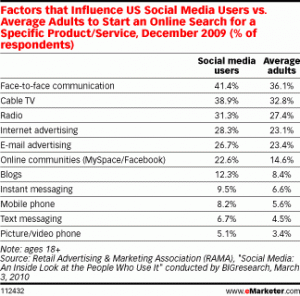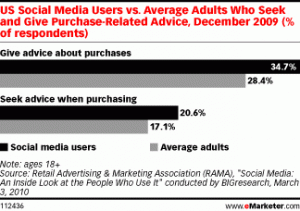Many of us may already know that word of mouth communication is the more highly trusted form of communications by consumers. But is it more powerful on or offline? According to ClickZ’s “Spurring Social Users to Search”, face-to-face communication is the preferred way of giving and receiving information about various products and services.
Research company BIGresearch for Retail Advertising & Marketing Association (RAMA) conducted a study on social media users’ main reasons for an online search of a particular item: in-person communication. Below is a table that illustrates the other drives for social media users to perform online searches.
Face-to-face communication help the top of the charts across all age groups, excluding one: 18- to 34-year-olds who were more likely to perform an online search because of what was seen on TV (which had a smaller influence among older social media users). Within this group, approximately three in 10 users searched because of social networks. In comparison, less than 20% of 35- to 54-year-olds and 15.3% of those 55 and older.
Other social media sites, including Facebook and MySpace, influenced less than one-quarter of social media users who search for products and services online. Women were less likely to report such an influence. Age also proved to have a larger impact on the results.
According to the article, social media users offer more of attraction for marketers since they are more likely to search and recommend purchasing advice than others. Below is a chart of social media users in the U.S. compared to average adults that search for and provide purchase-related advice.
According to the RAMA study, more than 71% of social media users communicated in-person about a product, brand or service after an online discussion or search. In comparison, a mere 21.6% of users spread information through word of mouth through sites such as Facebook and MySpace. Approximately one-half of individuals used e-mail to tell others what they found.
One reason for a preference for face-to-face communication over online WOM may be the personal and human aspect of the information and communication process. We can see where the information is coming from and understand the delivery on a more intimate level (human emotions, facial expressions, body language, etc.), whereas online, a lot of these are either non-existent or limited in certain ways (emoticons).
Another reason is that we can put a face to a name, thus deeming the information more credible and more genuine. Online communication can seem distant and with the amount of fraud that occurs online, it is hard to distinguish anonymity and misrepresented identities. It seems that although we live in a world that encompasses both online and offline interaction, traditional forms of face-to-face communication will not be taking a backseat to online social networks as much as the world thinks it might.
(All information is credited to the “Spurring Social Users to Search” article on ClickZ.com. Retrieved August 9, 2010 from http://www.emarketer.com/Article.aspx?R=1007555)


